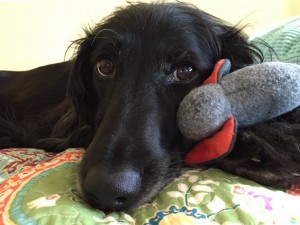 Well, it’s that time of year again here in the northern hemisphere: summer storm season. Here in northern New Mexico, where I live, our annual summer “monsoon” rains typically begin in early July and last through the end of August, though that is changing with the changing climate and persistent drought conditions.
Well, it’s that time of year again here in the northern hemisphere: summer storm season. Here in northern New Mexico, where I live, our annual summer “monsoon” rains typically begin in early July and last through the end of August, though that is changing with the changing climate and persistent drought conditions.
Additionally, in the US, this season coincides with our July 4 holiday, which in my home is known as the Most Hated Horrible Holiday because of the fireworks and their impact on so many animals and noise-sensitive people…including me.
I’m often asked if I can help animals who have thunderstorm and noise/fireworks anxiety symptoms through communication. The answer, as you might imagine, is not simple, as each animal is an individual, and each situation is unique.
In my experience, most frequently, communication can be one important aspect of a multi-pronged approach to helping animals with thunder and noise anxiety. It is rarely enough by itself without additional supports and interventions.
How Can Communication Help?
Thunder and noise anxiety is on a spectrum of intensity, from relatively mild to severe and debilitating. Most animals I’ve communicated with about these issues have shown me that their experience is a physiological, nervous system response. Many are impacted not only by the noise, but in the case of thunderstorms, the feeling in their bodies and nervous systems of the electrical charge in the air. They often also respond to changes in air pressure, which can feel much more acute than most humans are able to perceive.
Animals who have traumatic experiences related to these events often have more severe anxiety: for example, being lost or left outside during a storm, being purposely frightened by people with fireworks, or other kinds of traumatic events. However, it’s also the case that sometimes an animal will have very severe anxiety without any known associated trauma.
What is generally NOT helpful for animals with these issues is a communication intended to “help them understand”, such as,
“The thunder brings the rain and that is good for the earth, it’s nothing to be afraid of.”
“The thunder can’t hurt you, you’re safe.”
“I won’t let anything bad happen to you.”
These kinds of communications, while well-meaning, assume that the animal’s fear is thought-related; that it is a cognitive misunderstanding that, if corrected, will solve the problem. It’s a human-centric idea: if we can just explain to them what is happening in a way they can understand, they won’t be afraid. It doesn’t work that way.
Because these issues are physiological, rooted in the nervous system, using a kind of human-oriented “talk therapy” to address them generally isn’t helpful.
What CAN be helpful, however, is telepathic animal communication focused in these areas:
- Understanding what is going on from the animal’s perspective: what is their experience, what happens for them in these situations, what do they think and feel about it?
- Asking the animal what supports they might like or need, if they know and are able to communicate those needs, or presenting options to them to see if they are willing to try them.
- Communicate with the animal that you understand what is happening for them, and you will do your best to support them and help them.
Then, a specific, multi-faceted protocol of supports can be designed for the animal that takes into account what they have communicated and what they might be aware of that they need.
Helpful Supports
Here are some of the supports that can be helpful for animals. Many are dog or cat specific, as these tend to be the species that have the most challenges. If you are working with an animal of a different species, you may need to adapt some of these in species-specific ways.
Body wraps and swaddling:
These can be effective in helping to contain and calm the nervous system, particularly for animals who have shown that they are sensitive to the electrical charges and pressure changes in storms.
Two good options are:
Tellington Touch Body Wraps
Developed by Linda Tellington-Jones, this is a wrapping/swaddling protocol with many options to support animals with different issues, including anxiety and phobias.
Thunder Shirts for Dogs and Cats
These apply a gentle pressure through an elasticized garment that can help to calm the nervous system (similar to a weighted blanket for humans.)
Flower Essences and Pheromones
These are almost always worth trying, in my opinion, as part of a comprehensive support program. There are no contraindications for these supports.
Flower Essences: these can be added to water, food, or given directly by mouth. My preferred way to use them when an animal is really anxious is to put a few drops on the inside of the tip of the ear (not IN the ear), rub on the gums, or rub on the paw pads. Because they work energetically, rather than by dosage, a little goes a long way–a few drops are all that is needed.
I generally recommend getting them on board before a storm or other event, if possible, and then use periodically through the duration for acute anxiety.
Rescue Remedy-Bach Flower Essence: this is the most readily available, easily found at most natural food markets and many other places.
There are many other good flower essence companies that make similar formulas.
Pheromones are calming formulas that mimic a species-specific maternal hormone.They generally come in both spray and diffuser versions, as well as collars. They are helpful for many animals, and are widely available both online and in pet stores, and sometimes through veterinarians’ offices.
Thunder Ease (Adaptil) for Dogs
Calming Herbs and Medication
There are many different herbal formulas that can support animals with calming. It may take some trial and error to find one that works well for your animal companion. It’s best to talk to your veterinarian, whether holistic or conventional, to be sure that the formula is safe for your animal and does not have any contraindications for them, as well as to be sure of the correct dosing.
Many people are reluctant to use medication for their animal’s anxiety or thunder phobia, but it can be very helpful, especially in severe cases. Medication protocols and options have improved greatly in recent years, with fewer side effects and contraindications, and if your animal is really suffering and other supports have not been helpful, it’s well worth a conversation with your veterinarian to see if medication might be a good option for your animal. (Please don’t try to do this on your own with human or OTC meds without talking to your veterinarian.)
Safe Space and Comfort
Safe space: many animals will naturally take themselves to a quiet, dark place in the home. Examples may include:
- closets
- drawers
- under or behind furniture
- bathtubs
- crate
If your animal is comforted by this, you may want to use a special blanket and pheromones in this space.
Comfort: if an animal is comforted by your presence and wants to be close to you, let them. There is an old idea that this will reinforce the anxiety, but just as with human children, this is an outdated and inaccurate view. If an animal seeks touch and support, they are letting you know that it helps them. Some animals prefer to have no touch, so respect that as well. Some animals also want a special toy, blanket, or bed when they are upset.
Calming Music
There are more and more options for calming music created especially for dogs and cats, with more science-based research supporting its benefits.
Through a Dog’s Ear and Through a Cat’s Ear by Joshua Leeds and Lisa Specter have been shown to be helpful for many animals, and there are now other options available as well. Experiment and see if they may help your animal. There are options available on most music streaming services now, as well as “old-school” CD’s.
I’ve also found that relaxing, quiet “human” music, such as meditation music or quiet classical, can also be helpful for some animals.
Reiki
Reiki can really help some animals during times of situational anxiety. Hands-on Reiki can be used with an animal who seeks touch and comfort. For animals who prefer to have a safe spot, or who are restless and pace, Reiki from a distance, or a Reiki meditation, may be more helpful.
As with all Reiki, it’s important to use species-appropriate Reiki practices with animals. For more info, see How to Use Reiki with Animals and the Reiki for All Species Training Program.
Counter-Conditioning
This is a classical behavioral technique that is most effective in mild-moderate cases, or to prevent a problem in an animal who is already highly sensitive. (See this post for more on Highly Sensitive Animals.)
You’ll want to learn from a trained behaviorist or trainer to learn the protocol and steps, which involves pairing something your animal loves (treat, play) with a mild version of what scares them. This doesn’t work as well with animals who are not particularly treat or play/toy motivated (like my Afghan hounds), but can be helpful with animals who are.
Here are two excellent posts on thunder phobia in dogs by canine behaviorist Patricia McConnell at The Other End of the Leash that detail this approach, along with some of the other supports:
Case Study: Abby

In my home, my 14-year old chihuahua mix, Abby, has the worst thunder and noise anxiety. I would say her case is moderate. As she ages and her hearing diminishes, her anxiety is becoming less severe.
These are the supports I use that help Abby:
Rescue Remedy: Ideally, I start this 2-3 hours ahead of an approaching storm, if I can, and use every 45-60 minutes as needed until the storm stops.
Thunder Shirt: This really helps her, and she likes wearing it. She is a dog who accepts wearing clothes of all kinds, and so it is like another “jacket’ for her.
Adaptil: The thunder shirt I have for Abby has a built-in patch on the shoulder area where I can spray the Thunder-Ease Adaptil. This keeps it close to her body and seems to help her.
Comfort: Abby likes to snuggle up next to me, especially if she is under a blanket or cover. This reduces her overstimulation and sensory input. We usually go in the bedroom or on the sofa, close the blinds, and put on some soft music, and she gets under the covers.
Reiki: When Abby is next to me, I will offer her Reiki by putting a hand gently on the back of her neck or at the base of her tail as we sit together. It’s a simple way to share Reiki that doesn’t overwhelm her.
I hope that this post is helpful and will give you some ideas for your own animal friends. As always, if you need additional help and support, you may want to schedule a consultation.
May you and your animals have a safe and peaceful thunderstorm season!


